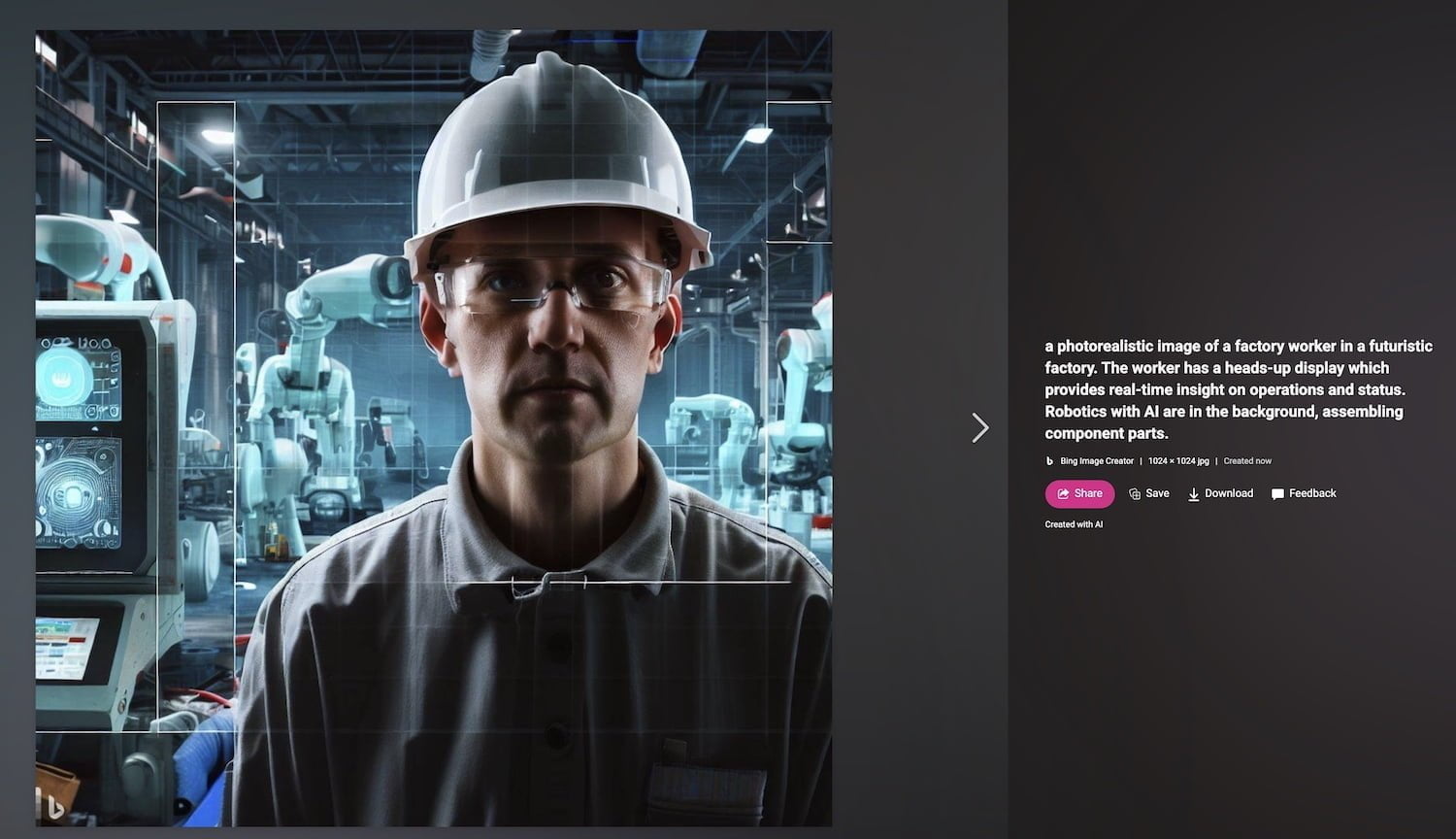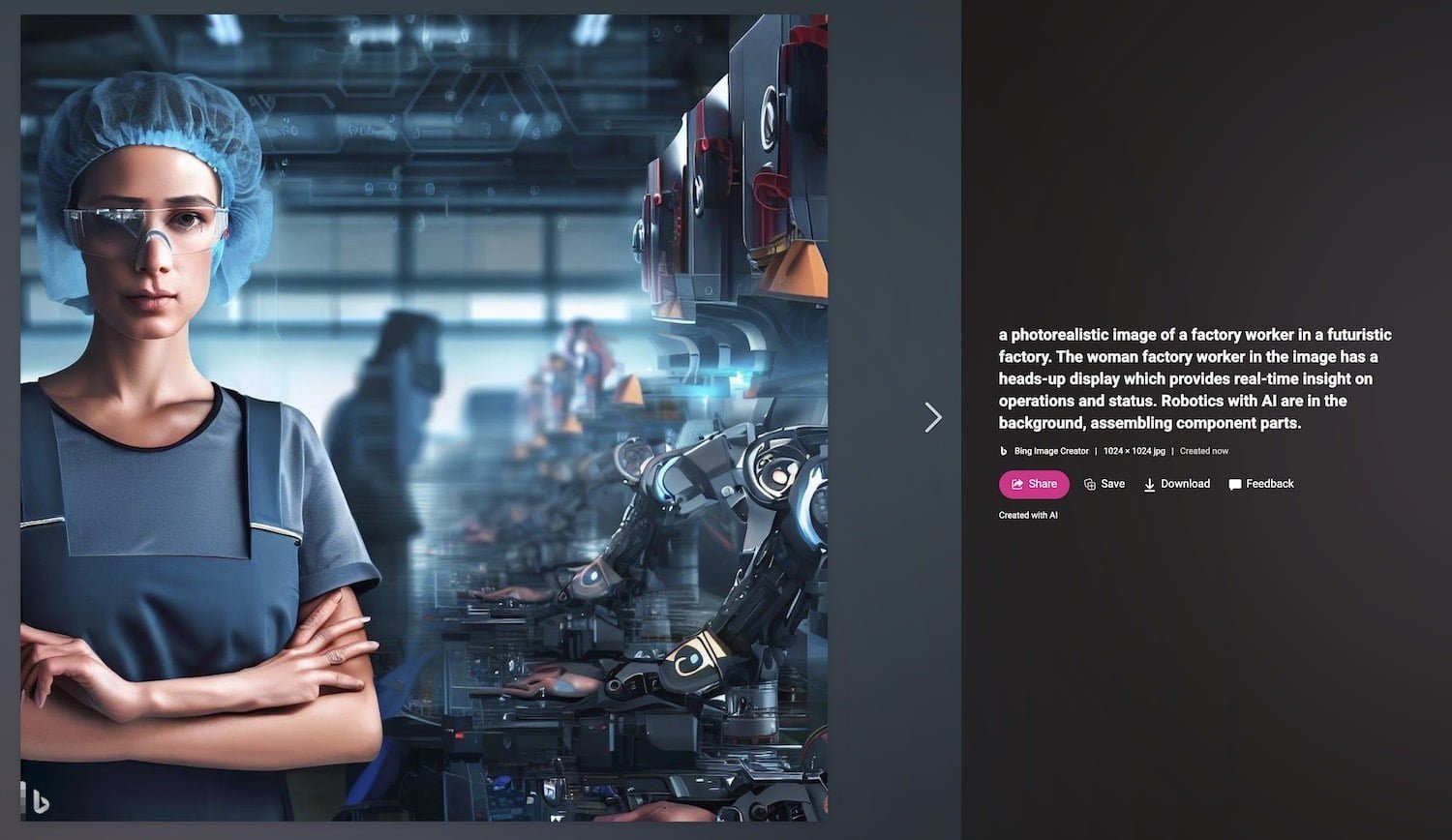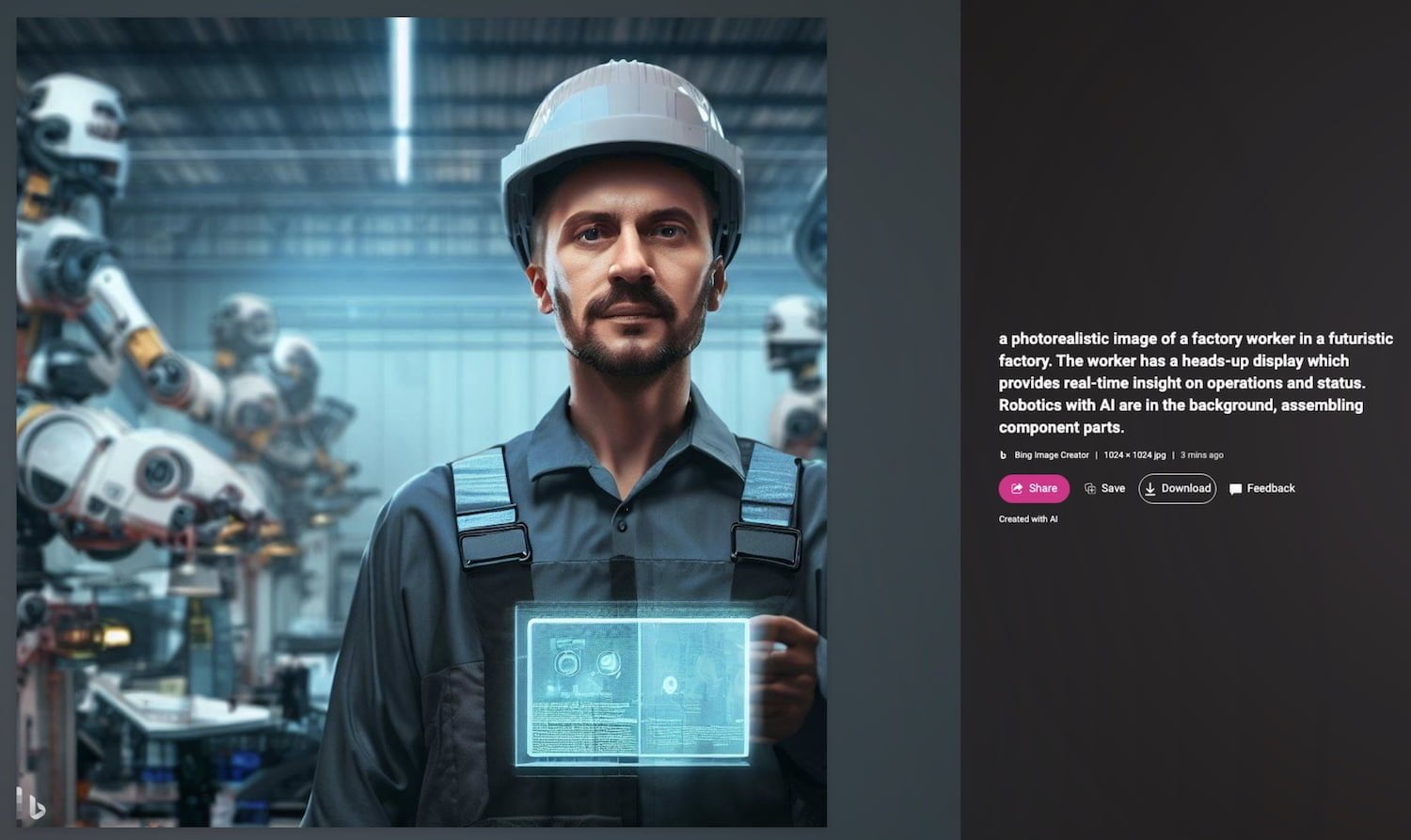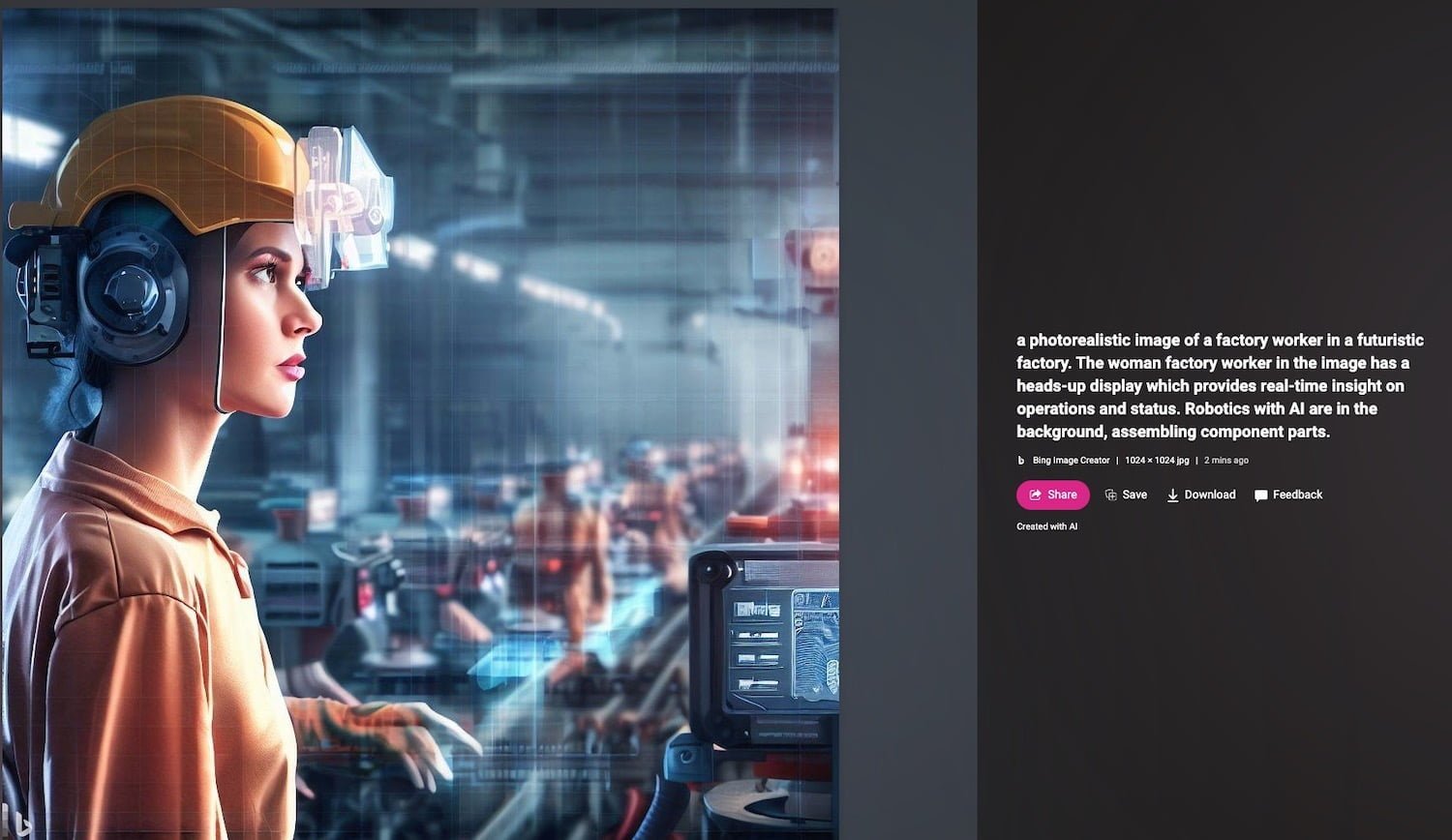What’s the future of AI in the world of manufacturing? The simple answer – since it is already in widespread use, there is a lot more yet to come!

Lofty promises
Consider the trends which have already led to a massive acceleration of everything having to do with the world of manufacturing. As I describe in my keynote description:
Collapsing product lifecycles. Mass customization. Digitization, robotics, and the cloud. Design based on crowd thinking. Build to demand, as opposed to building to inventory, business models. The role of the Internet of Things in product innovation as well as manufacturing process innovation. Spatial innovation with advanced manufacturing robotics. New materials and substances that allow for a change in product development. Rapid prototyping, sketch to scale, and agility-based business models…. are you ready for the new world of manufacturing?
While popular media and opportunistic politicians portray a picture of a sector in crisis, smart manufacturing executives are furiously busy with innovation, reinventing their capabilities, processes, and business models using advanced ideas, materials, methodologies, and technologies.
Among the benefits of artificial intelligence in Mexico’s manufacturing sector is supply chain optimization (companies can use machine learning algorithms to predict demand and adjust production accordingly, which can reduce costs and increase efficiency in the supply chain) and automated quality inspection (computer vision and machine learning algorithms can be used to identify defects in products during manufacturing, which can improve quality and reduce production costs).
Likewise, artificial intelligence can be used in collaborative robotics, (robots can work alongside employees to improve efficiency and productivity on the production line); and in predictive maintenance, (it can be used to monitor equipment and predict when maintenance will be needed, which can reduce downtime and associated costs).
Ikusi Mexico’s Director of Strategy and Product Development, Aurelio Sanchez, assured that artificial intelligence is a central element of the Industry 4.0 revolution, whose algorithms can be used to optimize manufacturing supply chains and thus help companies anticipate changes in the market. “Artificial intelligence is already positively impacting the machine learning part. Let’s remember that all production lines move through data or variables. All this data is converted into models that allow optimizing production lines and generating greater efficiency,” he said, adding that in this way, artificial intelligence is linked to efficiency and, therefore, allows generating a much more favorable environment for companies, and although this industrial revolution is still in its early stages, it is already generating significant benefits in processes ranging from the design process and the production floor, to the supply chain and administration.
Ikusi’s Analytics, Artificial Intelligence and Machine Learning manager, Juan Pablo Padilla, asserted that artificial intelligence is transforming the manufacturing sector, which is leading the way in the application of this technology. “Significant cuts in unplanned downtime and better designed products is what motivates, mainly manufacturers, to use and apply AI-based analytics to data to improve efficiency, product quality and employee safety,” he emphasized.
Padilla added that in addition to the fact that artificial intelligence can positively impact logistics planning, quality control, robotics and automation, inventory management, with its use, production plants will be able to increase productivity, using large volumes of information in a contextualized way, identifying the root of problems and also predicting their future behavior to be able to react in time to possible unforeseen events.
American Manufacturing Resurgence: Reshoring Accelerates Significantly And Manufacturing Becomes A Digital-First Industry As CEOs Invest In Emerging Technologies Like Artificial Intelligence (AI), Robotics And More
17 April 2023, Dow Jones Institutional News
The sector long ago realized that machine vision, robotics, data analysis, predictive diagnostics, and more, combined with AI, provide a powerful path into the future.

Now, as we enter the AI era of acceleration, what’s the potential impact? Massive! It’s certainly top of mind!
An accelerating number of CEOs whose companies depend on manufacturing to produce and deliver their goods are planning or have already successfully re-shored some of their overseas operations, the latest quarterly survey on American manufacturing resilience finds. The poll, a joint effort with Forbes, Xometry and veteran polling firm John Zogby Strategies, tracks CEO and decision-maker sentiment at more than 150 leading companies nationally and finds that 82% of CEOs have or are actively embracing reshoring strategies, up significantly from 55% in the previous survey fielded in January.
Fueling the reshoring strategy is growing optimism in American manufacturing. The survey finds that more CEOs — 71% now vs 64% in Q1 — believe there is enough manufacturing capacity in America to address the world’s supply chain concerns.
As they bring manufacturing closer to home, CEOs and their management teams are making good on their promise to embrace technology, especially AI, to modernize their operations and future- proof their businesses.
While 59% of CEOs saying investing in digital/automated workflows is their #1 strategy, a growing majority — 51% — are now investing in AI, significantly ahead of robotics, at 30%. Nearly all CEOs and decision-makers (97%) said they believe AI will play a large role in their future operations.
For those companies investing in AI, 68% have seen a significant ROI while just 27% of respondents say more time is required before they see any significant return. Only 5% are still developing AI for their operations.
Up to 40% more manufacturing production with the use of artificial intelligence: Ikusi
24 April 2023, CE NoticiasFinancieras
Key message? AI is already here – but there is a lot more yet to come. Like, a lot of LOT!
In the changed post COVID-19 business landscape, the global market for Artificial Intelligence (AI) in Manufacturing estimated at US$6.7 Billion in the year 2022, is projected to reach a revised size of US$181.2 billion by 2030, growing at a CAGR of 51.1% over the period 2022-2030. Machine Learning, one of the segments analyzed in the report, is projected to record 56.6% CAGR and reach US$97 bBillion by the end of the analysis period. Taking into account the ongoing post pandemic recovery, growth in the Natural Language Processing segment is readjusted to a revised 47.4% CAGR for the next 8-year period.
Global Artificial Intelligence (AI) in Manufacturing Market to Reach $181.2 Billion by 2030
1 April 2023, MarketResearch.com
That’s a pretty significant investment – $6.7 billion in 2022 to $181.2 billion in less than a decade.
Consider the Context!
Think about the context in which this massive trend is unfolding. Here’s a clip where on stage in Marrakech, Morocco, in my opening keynote for the World Bank / International Finance Corporation manufacturing conference – with the key reality being this:
Companies that do not yet exist will build products not yet conceived using materials not yet in existence with methodologies not yet defined.
That’s the reality of the future of manufacturing, and that’s the context in which AI technologies have already been used – and what will happen as those technologies continue to accelerate into the future. Are you aligned to a faster future?
The Role of AI in Manufacturing So Far
So what have we been doing with AI so far in the world of manufacturing? A lot – before ChatGPT arrived on the scene and had everyone in the world suddenly accelerating their interest in AI, it was already playing a huge role in manufacturing that goes far beyond the use in large language models:
- Robotics and cobots: Obviously, there is a massive reliance on robotics and cobotics (‘cooperative robots’ that work in closer proximity to humans), all of which involves the programming of a lot of routines and processes. Over the years, an increased amount of machine learning has been applied to these technologies, with the result that AI has taken on an increasing role on the factory floor.
- Digital twin technology: it’s one of the most exciting developments to have come into manufacturing in the last few years – virtualized replicas that we can examine and interact with at a lower cost than a real physical item. Essentially, during the product design and development phase, we can use a ‘digital twin’ of the product to virtually enhance, redesign and develop the product in an iterative process. We can also use ‘digital twin’ concepts to design a factory process before committing to the physical components and the associated cost. In both cases, Not only that, but
- Industrial Internet of Things. Essentially, it’s ‘sensor world’ on steroids – we can layer thousands of sensors into an assembly line, monitoring for real-time insight on conditions – the status of the line, errors, defects slowdowns, and physical world information such as temperature, vibration, and more. With a lot of sensors collecting a lot of ‘big data’ in real time on conditions, there is simply too much for a human to constantly monitor. That’s where an AI comes in – the algorithm is IIOT’s manufacturing friend, identifying what needs to be identified for corrective, follow-up action.
- Quality control: in that vein, IIOT can help us manage quality, but AI can take it even further, particularly with machine vision systems. We can use that to help instantly spot and detect defects, anomalies, and errors in products or processes.
- Predictive maintenance: AI can help monitor the condition and performance of machines and equipment, and predict when they need maintenance or repair, reducing downtime and costs. This is part of an overall trend of predictive diagnostics, wherein we are embedding a lot of connectivity into all the devices around us (IoT etc) and can use the generated data to examine the health and operating performance of those devices.
- Supply chain optimization: Supply chain technology cranks out a lot of numbers and a lot of data – we can track each step of the ay in a very complex manufacturing process and beyond, all the way to the final delivery to a customer. AI plays an extremely sophisticated role in helping us to optimize inventory, analyze demand forecasting, manage our logistics, and highlight delivery and shipment exceptions, as well as provide detailed insight on distribution bottlenecks and challenges
- Worker safety and training: AI is helping us to help improve worker safety and training by identifying and preventing potential risks, creating knowledge bases, and providing personalized guidance, particularly with advanced COBOT technology such as described above.
In essence, the benefits from AI in manufacturing come from automating repetitive tasks, speeding up our ability to analyze complex data sets and massive information stores, and allowing for an improvement in our overall decision-making.

Real-world applications
All of this is already underway: consider inspection and quality control. I have hundreds of articles like this from my research service.
With over 35 years of experience in electronics R&D as well as manufacturing, Might Electronics, launched a new plant in October 2021, which expanded its production capacity in Taiwan and also introduced the PowerArena AI vision inspection program, powered by the Advantech SKY-6400 industrial GPU server to their motor assembly line.
Managing Production Lines With Stopwatches Was Time-Consuming and Much Less Efficient The company’s previous motor assembly line relied on IE engineers conducting regular on-site visits with stopwatches to record the cycle time of each workstation. Due to limited manpower, IE engineers could only record about five cycles at each stop. Furthermore, stopwatch records contained only numbers without visual recordings, making it very difficult to discover the real reason behind excessive completion times, not to mention finding the right solutions.
In addition, the manual collection of cycle time data was an enormous burden for IE engineers. It took 1 to 2 working days just to collect data, which then had to be adjusted to confirm the cycle times of each station, leading to troublesome and time-consuming workloads.
Solution Might Electronics introduced the PowerArena AI visual inspection program, which has cameras set up at each workstation to collect images and send them to the Advantech SKY-6400 server for AI analysis. Cycle times can then be calculated instantly by referring to production times and quantities for each workstation and operator.
If the cycle time of a workstation shows an abnormality, the system will actively alert the managers to pinpoint the cause, and by replaying images of the abnormal workstation, managers will understand the cause of the abnormality. Ray from Might Electronics stated that “With real-time production line data, Might Electronics can dynamically adjust production line resources, optimize on-site manpower allocation, and ensure that the production line is always in balance. This allows us to improve the overall production performance.”
AI visual inspection in electronics manufacturing
20 April 2023, ETMAG.com
Going Forward!
So where does that investment of $6.7 billion today to $181.2 billion by 2030 take us? A lot more of the above – but even further with new opportunities.
- Circular economy and sustainability. Opportunities in further enhancing product development and design for ‘the circular economy,’ i.e. designing products not just for sale but for their eventual disposal. Think of batteries on electric cars.
- Heads-up display technology: Think “Google Glass 2.0” – we’ve seen the slow emergence of technologies that allow factory workers to instantly access assembly instructions, product manuals, and other information via the same type of heads-up display technology used in modern fighter jets. These systems can be linked to IIOT and other assembly technology, and updated in real-time spending on the status of the current operation.
- Mass customization: AI can help enable the production of customized products or services that meet the specific needs and preferences of individual customers, using data analysis, generative design, and additive manufacturing12. For example, AI can help design and produce personalized clothing, footwear, or jewelry2.
- New materials: AI can help discover and create new materials that have novel properties or functions, using data mining, machine learning, and computational chemistry12. For example, AI can help design and synthesize new drugs, catalysts, or alloys2.
- Further acceleration of digital twin technology: AI can help create and maintain digital twins of physical systems, such as factories, machines, or products, that can be used for simulation, testing, optimization, or training. For example, digital twins can help monitor and improve the performance of industrial equipment, vehicles, or buildings

Oh, and chatbots? They have a role too!
Andi is part of Smart Work Station powered by Andonix, accessible on any device and WhatsAppAndi can also learn company-specific information like machine operation and troubleshooting manuals, quality systems, HR manuals, and more, providing instant support for specific questions like how to fix particular machine failure codes, identifying the top three problems causing the most downtime in a machine, determining the FTQ for the last hour, or even clarifying company vacation policies. Andi offers unprecedented efficiency, productivity, and real-time guidance for factory teams, streamlining operations and continuously delivering data-driven insights to improve manufacturing outcomes.
Andonix Introduces Andi, the AI-Powered Manufacturing Chatbot
Revolutionizing Factories, 19 April 2023
Suffice it to say, when it comes to the world of manufacturing, we are busy manufacturing massive opportunities for AI!




GET IN TOUCH
Jim's Facebook page
You'll find Jim's latest videos on Youtube
Mastodon. What's on Jim's mind? Check his feed!
LinkedIn - reach out to Jim for a professional connection!
Flickr! Get inspired! A massive archive of all of Jim's daily inspirational quotes!
Instagram - the home for Jim's motivational mind!